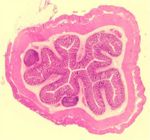Colon - Anatomy & Physiology
Introduction
The colon can be divided into the following portions:
- Ascending
- Transverse
- Descending
Structure
The following anatomocial arrangement is found only in cats and dogs, see species differences.
- The ascending colon continues from the iluem at the ileocolic junction.
- It runs to the right of the cranial mesenteric artery in a caudal to cranial direction.
- At the cranial border of the mesentry it turns medially to become the transverse colon.
- The transverse colon runs from the right side of the abdomen to the left side of the abdomen.
- Cranial to the transverse colon is the stomach, and caudal to it is the small intestine and cranial mesenteric artery.
- The descending colon continues on from the transverse colon running caudally on the left from the level of (???).
- It then passes more medially as it enters the pelvic cavity
- Upon entering the pelvic cavity it is continued as the rectum.
Function
Vasculature
Innervation
Lymphatics
Histology
- Mucosa has a columnar epithelium.
- Mucosa is thick.
- Mucosa has long glands.
- Submucosa has large lymphatic nodules which may interrupt the lamina muscularis.
- Lamina muscularis is incomplete.
Species Differences
Ruminant
- The ascending colon is the longest part of the colon and is composed of three parts:
- Ansa proximalis
- Has a sigmoid flexure that passes around the caudal border of the mesentry to the left side of the root of the mesentry.
- Ansa spiralis
- Consists of two centripetal turns and two centrifugal turns in the ox.
- There are three turns in the sheep and four in the goat.
- In the ox, the ansa spiralis is a flat disc, whilst in the small ruminants it takes the form of a cone.
- Consists of two centripetal turns and two centrifugal turns in the ox.
- Ansa distalis
- Goes back around the caudal border of the mesentry, to the right side of the root of mesentry.
- It then passes cranially adjacent to the mesentry until it reaches the cranial border of the mesentry.
- Ansa proximalis
- The transverse colon crosses the midline of the abdomen, from right to left at the cranial border of the mesentry.
- The descending colon continues caudally to the rectum and anus.
- It has a sigmoid flexure before it enters the pelvic cavity.
- Development
- The ox's ascending colon expands caudally around the root of the mesentry on the left side of the mesentry (compare to horse, where it expands cranially).
Horse
Pig
- The arrangement of the transverse and descending colon is similar to that of the dog and cat, but the ascending colon is different.
- The ascending colon is elongated and coiled to form a cone-shaped organ.
- The base of the cone is attached to the dorsal abdominal wall and the apex points ventrally.
- The position of the ascending colon varies with filling of the stomach.
- From the caecum, there are clockwise centripetal turns to the apex of the cone.
- Then the centrifugal turns run anti-clockwise on the inside of the cone.
- Centripetal turns have two taenia, whilst centrifugal turns have none.
